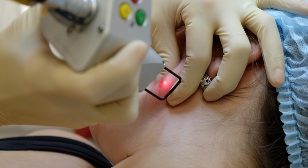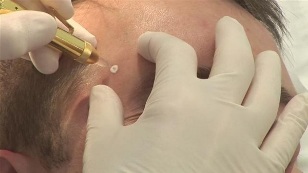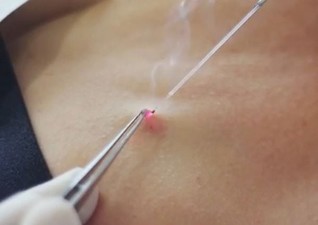
Laser tumor removal is a very common and effective procedure that helps get rid of unwanted growths. This is a relatively new method, which appeared in the medical arsenal a long time ago, but has already managed to prove its advantage over other methods of removal. Laser precursors were removed using liquid nitrogen, electricity, or a scalpel. All this could give the patient significant discomfort, while laser removal shows good results with painless intervention.
Why remove
Papules, which are growths of various shapes and sizes, are usually benign neoplasms. They are located in the mucous membranes of the body or skin. The main reason for their appearance is the action of the human papilloma virus, in most cases sexually transmitted.
Removing these accumulations does many things at once:
- Aesthetic correction.A developing patient may be uncomfortable with over-attention to them by others. Because of this, a person may feel insecure and uncomfortable, even if his development is not a danger to him.
- Injury prevention.If the growth is in a traumatic area where the patient is constantly touching it, this may lead to the separation of the protruding part. In addition, when trying to cover the nipple with clothes, such a problem can arise as rubbing the affected area. This is fraught with nipple injury and possible subsequent infection. Damage can lead to the penetration of germs, which can cause inflammation in the wound. If this happens, the damaged area should be treated with peroxide and you should go to the clinic immediately to have the rest of the papilla removed.
- Reduce cancer risk.Although growths are benign in nature, there is such a variety of manifestations as warts. They are usually found in familiar places and pose a high risk of developing cancer. To prevent the disease, all warts must be removed.
Do not remove the increments yourself. Any attempt to bind a papilla with a thread, comb, application of a chemical agent in it can worsen its condition.
Benefits of the process
Laser destruction has many advantages over other removal methods.These include:
- Guaranteed result.Thanks to the action of the laser, the overextension is completely removed, leaving nothing even in the deep subcutaneous layers. The device can penetrate deep enough to clear all traces of the presence of a tumor.
- Painless.Laser exposure gives the patient minimal pain. If you add pre-anesthesia with local anesthetics to the procedure, there is no pain at all.
- Process speed. Laser papilloma removal takes 2 to 5 minutes per item.
- Non-invasivenessThe laser beam is in a strictly limited area and does not exceed. In this case, more than one part of the laser does not touch the point of the procedure. This is very important, as this method helps to minimize the risk of infection and provides a high guarantee of infertility.
- There are no postoperative scars.If the job is done correctly, there should be no traces of laser action at the exposure site. This is because the affected tissue evaporates completely and then new, intact skin is replaced.
- Insoluble deletion method.The laser beam heats the capillaries that supply blood, quickly sealing their walls. As a result, the bleeding stops and does not recur after surgery.
- Suitable for different parts of the body.Not all removal methods can be used on every part of the body. Familiar parts, eyelids etc. are considered particularly sensitive. Laser destruction does a good job of tackling increases in these areas thanks to the precision of the laser beam.
All of these factors make laser removal one of the most sought after procedures to get rid of bumps.
Contraindications
The list of contraindications for this procedure is not as long as for other methods of destruction.Among the bans on laser removal:
- diabetes?
- oncology?
- exacerbation of chronic diseases?
- epilepsy?
- diseases associated with endocrine system problems.
- poor blood clotting.
- HIV or AIDS?
- acute inflammatory diseases.
In addition, patients who have recently had the flu or acute respiratory infections should also postpone the procedure for some time.
Process description
Before starting any procedure to remove the growths, the doctor will disinfect the area where the surgery will be performed. In some cases, a local anesthetic is used. Usually, an ointment or spray is used for this. After the application of the anesthetic drug, 2-3 minutes pass and the removal process begins.

The laser beam is directed at the affected area and, as it were, cauterizes the unwanted growth. At this time, the contents of the cells evaporate under the influence of the laser, removing each layer of infected tissue. This happens not only in easily accessible places in open spaces. The procedure for removing the papilla, for example, on the eyelid, is the same. The only nuance of this area is that a special cooling method is used for the patient to prevent pain and burns in this sensitive area.
Tumors in familiar places are removed according to the same principle. But here the doctor usually uses an anesthetic injection as an anesthetic, injecting growth from different angles.
The very moment of insertion of the needle can be a bit painful, but after a few minutes the sensitivity in the area of influence disappears completely and further manipulations are completely painless.
The affected area turns into a small wound without blood. At the time of destruction, it is disinfected due to the work of the laser. After removing the buildup, the doctor treats the affected area with potassium permanganate.
After the procedure, the patient may have slight redness, itching, or mild pain at the nipple removal site.
This reaction is considered normal, as, despite the non-invasive procedure, during the operation there was an intervention in the integrity of the skin.All discomfort should disappear completely 2-4 days after the procedure.
A dry crust appears later on the wound. Beneath this is a layer of already healthy skin, so its protective shell cannot be torn until it falls off on its own. Otherwise, a scar may remain on the skin and the healing process itself may take longer.
Consequences
Complications after laser destruction are rare. As a rule, their presence is related to diseases that the patient already has, which he had not cured before the procedure. Thus, for example, if the patient had skin inflammation, it may contribute to the appearance of pigmentation. If the skin itself is very sensitive, there may be a slight redness associated with burns. With a high allergic reaction, swelling may occur at the site of exposure.
To rule out any side effects, it is important to consult a doctor before performing laser destruction.
Post-procedure care
After removing the buildup, the patient must comply with the following rules: Several times a day, it is necessary to carry out antiseptic treatment of the wound. This should be done until the scabies separates. This treatment should prevent infection and help speed up the time of complete healing.To treat the damaged area, you can take iodine or potassium permanganate solution. After removal of the site can be treated with anti-inflammatory ointments. Their action aims to accelerate tissue regeneration, relieve inflammation and swelling. Before choosing a particular drug, it is best to consult a doctor. Laser removal is not the only way to deal with unwanted growth. There are other ways, among which they stand out: Cryodestruction. Based on the removal of papillae with liquid nitrogen. Due to exposure to low temperatures, the accumulation begins to collapse and eventually disappears completely. The method is effective, but has many disadvantages. Among them, the inability to fully control the depth of action of nitrogen. The substance can penetrate very deeply, touching a healthy area or, conversely, affect only superficially, without affecting all layers of localization of accumulation. In addition, this method is characterized by: Thus, laser destruction shows greater efficiency compared to cryodestruction. Laser removal is less painful and more likely to guarantee the desired result. Radio wave removal. This method of destruction is performed using a special device that acts on the nipple via radio waves. This promotes the excision of the accumulation due to the point effect of the radio knife. The accuracy of the procedure is very high, so as not to affect neighboring tissues. However, the risk of burns or infection is extremely low. This method is suitable for removing small benign lesions. It is very effective, which makes it as popular as laser destruction. Both methods are considered modern approaches to papilloma removal and are used equally well in medicine. Electrocoagulation. This method is based on the action of a high frequency electric current that affects the nipple directly at the site of the lesion. Electrocoagulation is now considered a common but outdated method. This method allows you to prevent bleeding after removal of the papilla burning vessels. However, when using high frequency current, patients experience pain that occurs even after anesthesia. This makes some patients abandon electrocautery, opting for laser removal as a more advanced and painless method. The price range depends not only on the area and clinic where the removal is performed, but also on the number, size and location of the deleted increments. In many clinics there is a discount for the removal of neoplasms in bulk: the more a patient has, the cheaper it will be to remove a growth. Getting rid of growth in the genital area can be much more expensive than in other parts of the body. In addition, not every clinic provides such a service due to the complexity of such treatment.Which method is better


Estimated cost














































































